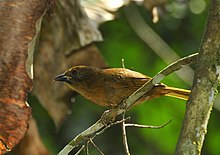Red-crowned ant tanager
| Red-crowned ant tanager | |
|---|---|

| |
| Male at Bertioga, São Paulo State, Brazil | |

| |
| Female at Miracatu, São Paulo State, Brazil | |
| Scientific classification | |
| Kingdom: | Animalia |
| Phylum: | Chordata |
| Class: | Aves |
| Order: | Passeriformes |
| Family: | Cardinalidae |
| Genus: | Habia |
| Species: | H. rubica
|
| Binomial name | |
| Habia rubica (Vieillot, 1817)
| |

| |
The red-crowned ant tanager (Habia rubica) is a medium-sized passerine bird from tropical America. The genus Habia was long placed with the tanagers (Thraupidae), but it is actually closer to the cardinals (Cardinalidae). Consequently, it can be argued that referring to the members of this genus as ant-tanagers is misleading, but no other common name has gained usage.
Red-crowned ant tanagers are 18 cm (7.1 in) long and weigh 34 g (1.2 oz) (male) or 31 g (1.1 oz) (female). Adult males are dull reddish brown with a brighter red throat and breast. The black-bordered scarlet crown stripe is raised when the bird is excited. The female is yellowish brown with a yellow throat and yellow-buff crown stripe.
The Red-crowned ant tanager is a shy but noisy bird. Its call is a rattle followed by a musical pee-pee-pee.
This bird is a resident breeder from Mexico south to Paraguay and northern Argentina, and on Trinidad. Common in its wide range, it is not considered threatened by the IUCN.[1]
It preferentially occurs in the middle stratum of the forest as well as undergrowth rich in ferns, shrubs and herbs.[2] These birds are found in pairs or family groups. They eat mainly arthropods, but berries are also taken. In Central America and Trinidad they frequently attend army ant columns, and in the lowland forests of southeastern Brazil they may be a nuclear species of understory mixed-species feeding flocks – though further uphill, e.g. in the , they seem to join such flocks only rarely and prefer to follow the ants on their own.[3] They also follow South American coatis (Nasua nasua) on their feeding excursions, namely in the dry season.[4] In both cases, they are commensales, snatching invertebrate prey startled by the ants or coatis.
The shallow cup nest is usually built in a sapling or tree fern near a stream, and the normal clutch is two brown-blotched white eggs. The female incubates the eggs for 13 days prior to hatching, with about ten days more before the chicks fledge.
References[]
- ^ a b BirdLife International (2020). "Habia rubica". IUCN Red List of Threatened Species. 2020: e.T22722409A138397027. doi:10.2305/IUCN.UK.2020-3.RLTS.T22722409A138397027.en. Retrieved 12 November 2021.
- ^ de Lima Favaro, Fernando; dos Anjos, Luiz (2005). "Microhabitat de Habia rubica (Vieillot) e Trichothraupis melanops (Vieillot) (Aves, Emberizidae, Thraupinae), em uma floresta atlântica do sul do Brasil" [Microhabitat of Habia rubica (Vieillot) and Trichothraupis melanops (Vieillot) (Aves, Emberizidae, Thraupinae) in an Atlantic Forest, Southern Brazil] (PDF). Revista Brasileira de Zoologia (in Portuguese). 22 (1): 213–217. doi:10.1590/s0101-81752005000100026.
- ^ Machado, C.G (1999). "A composição dos bandos mistos de aves na Mata Atlântica da Serra de Paranapiacaba, no sudeste brasileiro" [Mixed flocks of birds in Atlantic Rain Forest in Serra de Paranapiacaba, southeastern Brazil] (PDF). Revista Brasileira de Biologia (in Portuguese). 59 (1): 75–85. doi:10.1590/S0034-71081999000100010.
- ^ de Mello Beisiegel, Beatriz (2007). "Foraging Association between Coatis (Nasua nasua) and Birds of the Atlantic Forest, Brazil". Biotropica. The Association for Tropical Biology and Conservation. 39 (2): 283–285. doi:10.1111/j.1744-7429.2006.00255.x.
Further reading[]
- Skutch, Alexander F. (1954). "Red ant tanager" (PDF). Life Histories of Central American Birds. Pacific Coast Avifauna, Number 31. Berkeley, California: Cooper Ornithological Society. pp. 176–182.
External links[]
| Wikimedia Commons has media related to Habia rubica. |
| Wikispecies has information related to Habia rubica. |
- "Red-crowned Ant-tanager media". Internet Bird Collection.
- Red-crowned Ant-tanager photo gallery at VIREO (Drexel University)
- Red-crowned Ant-tanager species account at Neotropical Birds (Cornell Lab of Ornithology)
- Interactive range map of Habia rubica at IUCN Red List maps
- IUCN Red List least concern species
- Habia (bird)
- Birds of Central America
- Birds of Trinidad and Tobago
- Birds of the Amazon Basin
- Birds of the Atlantic Forest
- Birds described in 1817
